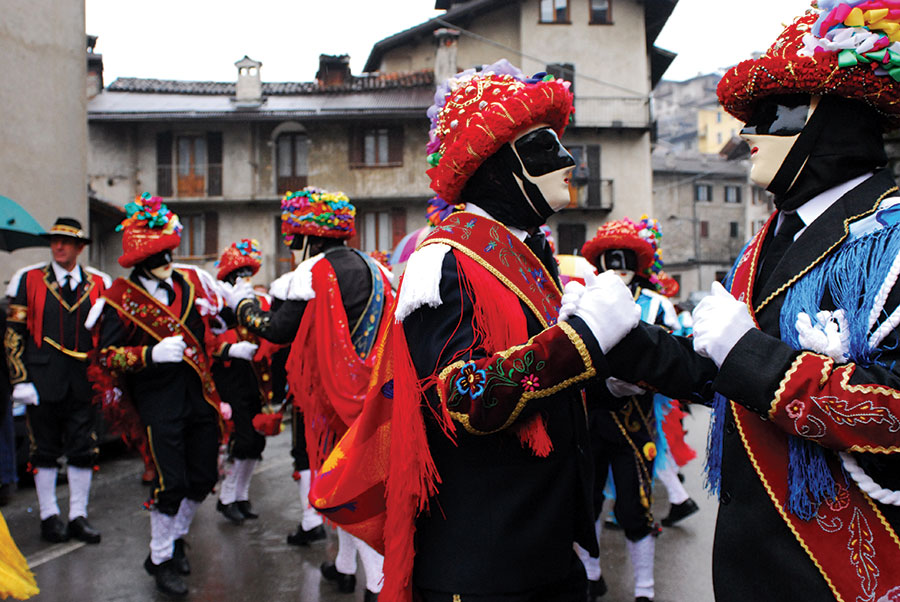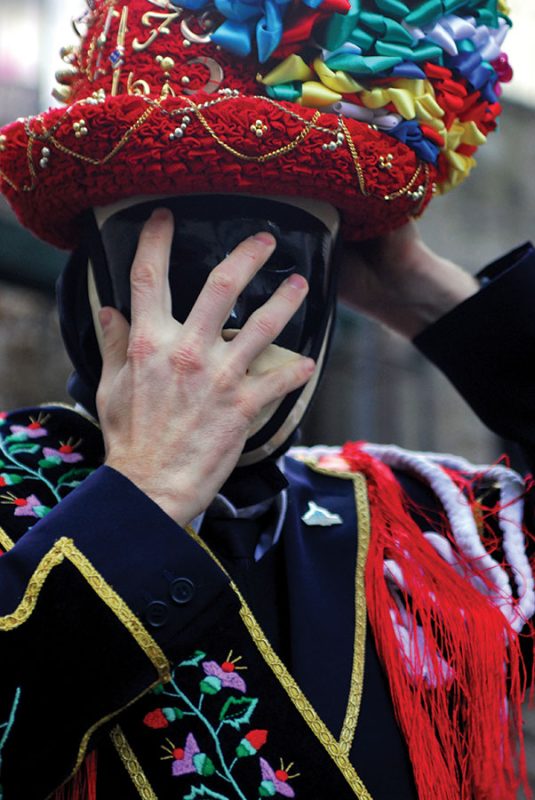We follow Marina Spironetti in her discovery of the Bagolino winter carnival – one of Italy’s most beautiful and lesser-known carnivals…

Getting to the small town of Bagolino was quite a job. It might have been because of my not-so-accurate map, but certainly the winding mountain road that eventually took me there was neither the quickest nor the easiest route.
Not to mention the snow that started to fall halfway there.
Best known for Bagoss, the hard cheese that is produced here, Bagolino is less famous for its carnival, and one can easily understand why, tucked away as it is in a remote corner of Alpine Italy.
The Bagolino winter carnival
Still, when a team of Italian researchers stumbled onto it in 1972, this very peculiar carnevale was declared the most important ethnological discovery of the last 200 years. Thanks to its centuries-long geographic isolation, this mountain village had developed a tradition of its own – a marvel of sounds, colours, ancient dances and traditional costumes. A carnival with a difference.
My festive celebrations start very early in the morning. The sun hasn’t come up yet and the streets are still shrouded in darkness. Only patches of snow glow in the night.
All of a sudden, the village peace is interrupted by something that to my ears sounds like horseshoes echoing off the cobbled alleys. A group of people are walking down the lane.
They are all dressed in black, head to toe. The girls have bright shawls draped over their shoulders; the boys wear grotesque masks and speak in altered voices. But it is their shoes that demand my immediate attention: the soles are made of thick wood, and it is in this footwear that they walk noisily up and down the town, clip-clopping.
They are the ‘Mascher’, the costumed figures that traditionally represent the poorest part of the population; the scenes they portray are those of country life and their jokes are unsophisticated – and often openly erotic.
Early morning encounter
My early morning encounter with this unbridled and riotous bunch is only just the beginning of the carnival, however. Hidden behind closed doors, the dancers are getting ready to begin their strenuous two-day performance.
Watching them dress is a bit like taking part in the preparation for a wedding – there is the same excitement and the same solemnity. Known as the ‘Balarì’, they wear a richly adorned costume with a particularly striking hat. This is created by sewing together several metres of red ruffled ribbon, onto which jewels and decoration are fixed.
On one side of the hat, a big multicoloured silk ribbon garland is fixed; its rhythmic movement during the dance is accentuated by the dancer shaking his head.
Before the dancing can officially start, this colourful crowd attends a 6.30 am service. Hundreds of disguised men in a church, their masks and hats dutifully lined up at each side of the altar – that is quite an impressive sight.
A beautiful sunshine greets us on our way out – the fog is clearing and the valley is glowing in the morning light. The vivid colours of the dancers’ costumes stand out against the bleak horizon of mist and snow. I have the impression of travelling back in time, to a parallel universe still beautifully untouched by the modern world.
It’s time for the music to begin once again. The origins of this Bagolino winter carnival are lost in time – according to archive documents, the dances and music date back to the first half of the 16th century.
The repertoire is made up of 24 dances – the elaborate choreographies convey ancient symbols of challenges, courtship, erotic acts and court dances.

Perhaps because of the full-face masks, the Balarì have developed a rich language of body movements, and particularly hand gestures – the latter emphasised by their white gloves – which enables them to fully express their personality from within the total disguise of the costume.
They dance to the cheerful and upbeat melody of the violin players, to that same music that has been passed down orally from one generation to another over the centuries.
The temperatures are low, but dancing can fight the cold. The Balarì perform along the streets, stopping in fixed places and following the instructions of the chief dancer, who is the only unmasked one.
The show, though replicated for two days, is always exciting. And when it gets too cold to follow the crowds, there is always a warming mug of mulled wine from one of the bars in town.
Bagolino winter carnival’s collective dance
At the end of the two-day celebrations a big collective dance, known as the ‘Ariòsa’, marks the end of the carnival.
Unlike the other dances, which always have dancers facing one another in pairs along two parallel rows, this last one is danced in a vast circle, which takes up almost all the space in Piazza Marconi, the town’s largest square.
The Carnevale is over – tomorrow the sober celebrations for Lent will begin in preparation for Easter. And the Ariòsa is the last chance to dance and be merry.
Still, the melody of the Bagolino’s violins will be ringing in our ears for a long time to come.
All images © Marina Spironetti
Discover another Italian winter wonderland in the Dolomites
